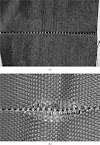Production Systems in Garment Industry
Production systems introduce the way of material handling, production process, operators training and floor layout that directs the work flow. Information about a different production system will enable you to adopts and arranges a efficient production system for a organisation. Being known for studying time will also assist you in the design of an efficient and effective production system. It will result in better production in less time.
Following are the basic production systems –
1. Unit Production System
• Unit production system uses overhead transporter system like conveyor to move the pieces from one machine to another.
• Carriers move all the pieces of the one complete garment to every workstation.
• Operators receive the pieces through carrier, perform the operation and send it to next operator by pressing the button which will move the carrier to the next workstation.
• Likewise all the garments are moved through the production system.
• It has a computer controlled centre to track the production.
• It also provides the information of inventory, time required for individual piece, efficiency, piece rate, WIP, etc.
• E.g. Eton system, switch track system
Advantages –
• Low WIP.
• Defects can be less.
• Improves lead time.
• More flexibility.
• Increase space utilisation.
• Improve productivity.
• Handling is reduced.
• High quality of garments can be made.
Disadvantages –
• Highly expensive.
• High cost for specialised training.
• Requires skilled operators.
2. Progressive Bundle System
• Bundle system is the widely used production system in the garment industry for long time. Today also most of the garment industry prefer bundle production system.
• This system is helpful to utilize each specialised sewing machine in the production line.
• According to AAMA Technical Advisory Committee, 80 per cent of the apparel manufacturers use the bundle system.
• In this system cut parts are tied into a bundle.
• A stack of bundle is positioned at each machine.
• Bundles of garment parts are moved in sequence from operation to operation.
• Each bundle is needed to be done a specific operation/task.
• E.g. a bundle ne to be perform yoke attach to back includes back and yoke pieces.
• Each operator is doing same operation everyday, which leads operator to lack of multitasking.
Advantages –
• No requirement of specialised training for workers.
• Production is more.
• No expensive inventory.
• Utilisation of specialised machine.
Disadvantages –
• Operators lack in skills in multitasking.
• Large inventory.
• Hugh WIP
• Machine failure may cause major bottleneck.
• Extra handling.
3. Modular Production System
 |
| https://textilestudycenter.com |
• Modular production system consists of a functional, manageable work environment that includes a delegated work team, machinery and work to be done.
• It is one of the newest production system in the garment industry.
• It groups operators in teams or modules.
• Their is interdependency that utilizes everyone’s strength.
• Each operator is trained to perform 3 to 4 operation.
• The operator rotates across several machines to perform various operations.
• It is pull system which demands WIP from next operator.
• WIP is less in this system.
Advantages –
• Operators can do more than one operation.
• High flexibility.
• High productivity.
• Less WIP
• Fast throughput time.
• Improve the quality.
Disadvantages –
• High investment in machines.
• Low production.
• High cost incurred in specialised training.













5 Comments
national conveyors company
ReplyDeleteMachine Work Study in Garment Manufacturing Factories
ReplyDeleteThanks for sharing. Diaphragm Wall Grabs and the advanced Diaphragm Wall Grab Machine. Ideal for Diaphragm Wall Basement Construction, these machines, available for Rental Construction Equipment, offer unparalleled efficiency. Elevate your projects with Heavy Equipment Rental, ensuring versatility and precision in every excavation endeavor
ReplyDeleteOne of the main reasons for Bangladesh's success is its competitive pricing. Manufacturers in Bangladesh offer lower production costs compared to other countries. This cost-effectiveness does not compromise quality. In fact, bangladesh clothing manufacturers are known for their high standards and durability. Brands worldwide trust Bangladeshi manufacturers for their reliability and quality assurance.
ReplyDeleteBangladesh has become a global powerhouse in the garment manufacturing industry, renowned for its efficiency, affordability, and quality. As a leader in apparel production, garments manufacturer in bangladesh sector plays a pivotal role in the country's economy, providing employment to millions and contributing significantly to its GDP. This article delves into the nuances of garment manufacturing in Bangladesh, exploring its history, advantages, key players, challenges, and future prospects.
ReplyDeleteIf you have any doubts, please don't hesitate to ask